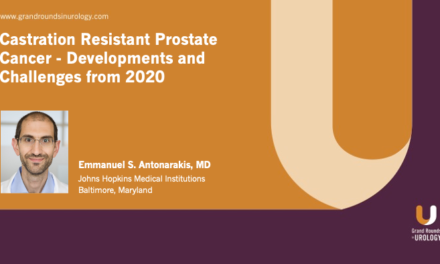William K. Oh, MD, presented “New Standards of Care for Advanced Prostate Cancer” during the 25th Annual Southwest Prostate Cancer Symposium conference on December 11, 2021, in Scottsdale, Arizona.
How to cite: Oh, William K. “New Standards of Care for Advanced Prostate Cancer.” December 11, 2021. Accessed Oct 2024. https://grandroundsinurology.com/new-standards-of-care-for-advanced-prostate-cancer/
New Standards of Care for Advanced Prostate Cancer – Summary
William K. Oh, MD, Clinical Professor of Medicine at the Icahn School of Medicine at Mount Sinai, and Chief Medical Officer of The Prostate Cancer Foundation, addresses new standards of care in 2021 for advanced prostate cancer and shares a sankey diagram illustrating that treatment for metastatic prostate cancer is heterogeneous. Dr. Oh discusses non-metastatic castration-resistant prostate cancer (nmCRPC) and hormone therapy, citing three randomized clinical trials: SPARTAN (apalutamide vs. placebo), PROSPER (enzalutamide vs. placebo), and ARAMIS (darolutamide vs. placebo). He shares a graph that illustrates that as prostate-specific antigen (PSA) doubling time (PSADT) decreases—especially to less than 10 months—risk for bone metastasis or death greatly increases. Dr. Oh shares metastasis-free survival (MFS) data and explains that with SPARTAN (apalutamide), the MFS benefit was 24 months; in PROSPER (enzalutamide), the MFS benefit was 22 months; and with ARAMIS (darolutamide), the MFS benefit was 22 months. He then shares OS data across the three studies and posits that the data suggest early use (at the non-metastatic phase) of androgen-receptor (AR)-targeted therapies leads to survival improvements. Dr. Oh concludes that apalutamide, enzalutamide, and darolutamide improve MFS in men with nmCRPC by ~2 years; SPARTAN, PROSPER, and ARAMIS established favorable benefit-risk for patients with nmCRPC and PSADT<10 months; and these studies provide the best evidence supporting early treatment. He then switches gears to focus on metastatic, hormone-sensitive prostate cancer (mHSPC). Dr. Oh cites more treatment choices, supported by the ARCHES, ENZAMET, TITAN, and ARASENSE studies. Dr. Oh highlights OS data for the ENZAMET study, emphasizing that enzalutamide was associated with significantly longer OS vs. standard care in men with mHSPC. He also highlights OS data from the TITAN study that suggest the addition of apalutamide to ADT resulted in significantly longer OS compared with placebo plus ADT in men with mCSPC. Dr. Oh then summarizes takeaways from PEACE-1 study and shows OS results in the context of recent data from a number of other studies. These showed the median OS data based on a variety of treatments: ADT alone (33-35 months) ADT+docetaxel (40-48 months) ADT+abiraterone (50-56 months) ADT+docetaxel+abiraterone (61 months). Dr. Oh concludes that for mHSPC, upfront treatment with either abiraterone + prednisone, apalutamide, enzalutamide, or docetaxel is the standard of care and he asserts that new evidence from PEACE-1 and ARASENS supports triple therapy with a novel hormonal therapy +ADT+docetaxel for chemotherapy patients. Dr. Oh ends his talk by emphasizing there are more available treatments and the importance of shifting to earlier treatment, acknowledging that more curative treatments are needed.
About the 25th Annual Southwest Prostate Cancer Symposium:
Presented by Program Chairs Nelson N. Stone, MD, and Richard G. Stock, MD, this conference educated attendees about advances in the management of localized and advanced prostate cancer, with a focus on imaging, technology, and training in the related devices. It included a scientific session, as well as live demonstrations of surgical techniques. You can learn more about the conference here.
ABOUT THE AUTHOR
Dr. William K. Oh is Chief Medical Officer at the Prostate Cancer Foundation (PCF), the world’s leading philanthropic organization dedicated to the eradication of prostate cancer and is also a Clinical Professor of Medicine in the Division of Hematology and Medical Oncology at The Tisch Cancer Institute of the Icahn School of Medicine at Mount Sinai. He is an expert in the management of genitourinary malignancies, including prostate, renal, bladder, and testicular cancers.
Dr. Oh received his MD from New York University School of Medicine. He completed his internship and residency in internal medicine at Brigham and Women’s Hospital in Boston. Dr. Oh completed a fellowship in medical oncology at the Dana-Farber Cancer Institute.
For two years prior to joining PCF, Dr. Oh was the Chief Medical Officer at Sema4, a patient-centered health intelligence company. From 2009-2020, Dr. Oh was Chief of the Division of Hematology and Medical Oncology at the Mount Sinai Health System and Deputy Director of The Tisch Cancer Institute, an NCI-designated cancer center, at Mount Sinai. Dr. Oh spent 14 years at Harvard Medical School and the Dana-Farber Cancer Institute in Boston, including service as Clinical Director of GU Oncology and Associate Professor of Medicine.
Dr. Oh has authored more than 350 original articles, reviews, and book chapters on topics relating to prostate, renal, bladder, and testicular cancers. He has edited three books on prostate cancer. He has served in key invited roles for the American Society of Clinical Oncology (ASCO), the American Cancer Society (ACS), and the American Urological Association (AUA), including the Guidelines Committee for Castration-Resistant Prostate Cancer. In addition to reviewing for prominent journals such as the New England Journal of Medicine, Journal of Clinical Oncology, and Cancer, Dr. Oh was inducted into the prestigious American Society for Clinical Investigation (ASCI) and has been repeatedly selected as a Top Doctor in New York Magazine, Castle Connolly, Best Doctors, and Super Doctors.



